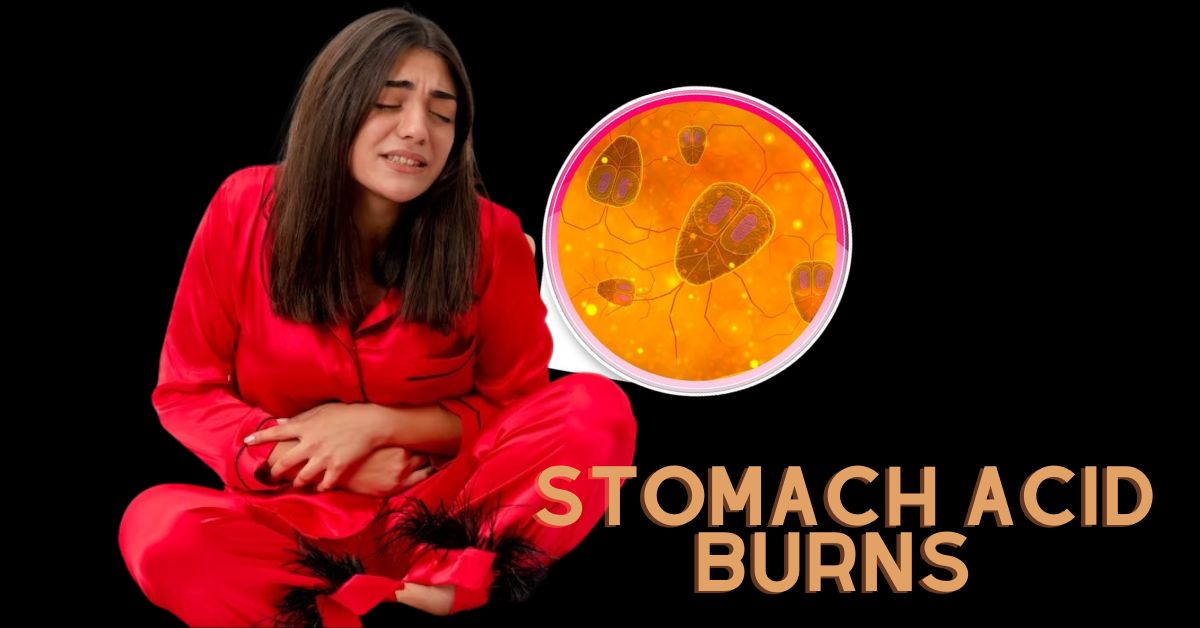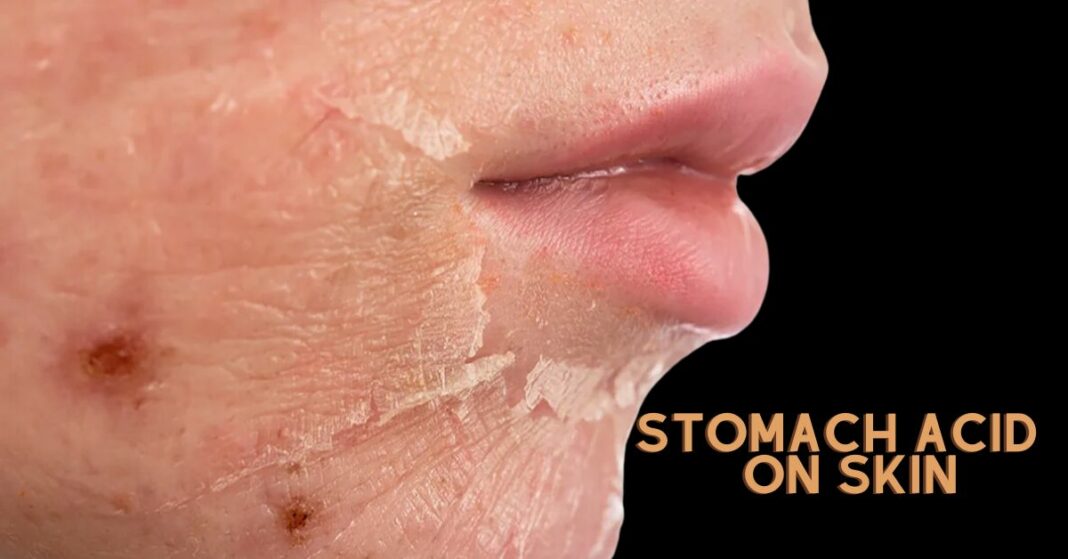Stomach Acid Burns on Skin: Side Effects & Precautions

Stomach acid, with a pH level between 1 and 2, mirrors the acidity of substances like battery acid. Unlike our stomach, our skin lacks the protective mucus layer. Understanding the potent acidity is crucial to comprehend its impact on the skin.
Our skin, being vulnerable to stomach acid, necessitates protection. While the stomach has built-in defenses, the skin does not share the same resilience. This makes safeguarding the skin paramount to prevent adverse reactions and burns.
The potential effects of stomach acid on the skin range from mild irritation to more severe burns. It is essential to delve into these effects to comprehend the gravity of exposure and take appropriate preventive measures. This sets the stage for a closer look at how stomach acid interacts with the skin.
Also Read: LIIT Cardio Guide
How Stomach Acid Burns Occur
Stomach acid is inherently powerful, boasting a pH level between 1 and 2. The stomach, however, possesses robust protective mechanisms. A thick layer of mucus and specialized cells shields it from the corrosive effects, allowing the stomach to withstand its own acidity.
When the mucus layer is compromised, stomach acid can lead to the formation of ulcers. Understanding this vulnerability highlights the importance of maintaining the stomach’s protective barriers. Disruption of these defenses may occur in various scenarios, increasing the risk of acid-related complications.
The severity of burns on the skin caused by stomach acid can range from mild irritation to more profound effects, such as blistering and ulceration. While the skin lacks the stomach’s inherent protection, the comparison to battery acid emphasizes the potential seriousness of these burns. Recognizing this severity underscores the need for proactive measures to prevent and address stomach acid exposure to the skin.
Effects on the Skin
Mild Irritation Symptoms
Mild exposure to stomach acid may manifest as a tingling or burning sensation, accompanied by redness and swelling. These early symptoms signal the need for immediate attention to prevent escalation.
Severe Burns, Blistering, Ulceration, and Scarring
In severe cases, stomach acid can inflict deep burns, leading to blistering, ulceration, and potential scarring. Recognizing the gravity of these effects underscores the urgency of addressing severe exposure promptly.
Situations Leading to Stomach Acid Contact with the Skin (Vomiting, GERD, Feeding Tubes)
Stomach acid can come into contact with the skin during vomiting episodes, especially forceful or prolonged ones. Individuals with Gastroesophageal Reflux Disease (GERD) face an increased risk as acid may back up into the mouth. Similarly, those with feeding tubes should be cautious, as leaks can expose the skin to stomach acid. Understanding these situations is crucial for implementing preventive measures and minimizing the risk of skin exposure.
Also Read: Best Time to Go to the Gym
Dealing with Stomach Acid Burns on Skin
In cases of mild exposure to stomach acid, swift action is paramount. Begin by rinsing the affected area with cool water for at least 15-20 minutes. This aids in removing the acid from the skin and mitigates the initial symptoms. Following the rinse, applying a soothing lotion can further alleviate discomfort.
For instances of severe exposure, immediate medical attention is crucial. Do not attempt self-treatment. Instead, seek professional help promptly. The severity of burns caused by stomach acid requires specialized care to prevent complications and ensure proper healing.
It is essential to avoid attempting to neutralize stomach acid with other substances. Neutralization attempts can exacerbate the burn. The recommended approach is to flush the affected area with cool water consistently. This helps dilute and remove the acid without introducing potentially harmful reactions.
Prevention of Stomach Acid Burns
To prevent skin exposure during vomiting episodes, consider covering your mouth and nose with a cloth or tissue. This simple yet effective measure minimizes the risk of stomach acid coming into contact with the skin, offering an additional layer of protection.
If you suffer from Gastroesophageal Reflux Disease (GERD), proactive management is key to preventing acid reflux. Consult with your healthcare provider to explore treatment options and lifestyle changes that can help control GERD, reducing the likelihood of skin irritation and burns.
Individuals with feeding tubes should prioritize proper securing and cleanliness. Regular checks to ensure the tube is securely in place, along with maintaining cleanliness to prevent leaks, are essential steps. This diligence helps minimize the risk of stomach acid leaking around the tube, safeguarding the skin from potential exposure.
Seeking Medical Attention
Recognizing the importance of prompt medical assistance is crucial in mitigating the consequences of stomach acid burns. Swift intervention by healthcare professionals ensures an accurate assessment of the burn severity and the implementation of appropriate medical care. Delaying medical attention can exacerbate the situation, underscoring the urgency of seeking help promptly.
When faced with severe burns caused by stomach acid, refraining from self-treatment is essential. Unlike mild exposure, severe burns demand specialized medical expertise. Attempting to address these burns independently can lead to complications and hinder the healing process. Trusting the expertise of medical professionals is paramount for optimal recovery and minimizing long-term effects.
Also Read: Nine Dimensions of Wellness
Conclusion.
In summary, understanding the potential effects of stomach acid on the skin is crucial. From mild irritation to severe burns, the spectrum of outcomes highlights the need for awareness and preventive measures.
The key takeaway is the importance of prevention and immediate action when dealing with stomach acid burns on the skin. By taking proactive steps, such as covering the mouth during vomiting, managing GERD, and ensuring the proper maintenance of feeding tubes, individuals can significantly reduce the risk of exposure.
Remember, in cases of exposure, swift and appropriate action is the linchpin for minimizing the impact. Whether it’s mild irritation or severe burns, seeking medical attention promptly ensures the best possible outcome.
Stay informed, take preventive measures, and act promptly – safeguarding your skin from the corrosive effects of stomach acid is paramount for overall well-being.
Thank you for joining us on this fitness journey! We hope you found our blog insightful and inspiring. Our aim is to provide you with valuable information, expert advice, and motivational content to support you in your wellness endeavors.
Related Post.
- Immunity 101: The Best Juices to Boost Your Immunity This Winter
- Unlocking the Mystery of Temporomandibular Joint (TMJ)
FAQs about Stomach Acid Burns on Skin
If you experience mild exposure, it's crucial to act promptly. Rinse the affected area with cool water for at least 15-20 minutes. This helps remove the acid and alleviate initial symptoms. Follow up by applying a soothing lotion to ease any discomfort. For mild exposure, home treatment is possible by following the recommended steps. However, in cases of severe burns, seeking immediate medical attention is crucial. Professional care ensures an accurate assessment of burn severity and the implementation of appropriate medical interventions. Yes, situations such as forceful or prolonged vomiting, Gastroesophageal Reflux Disease (GERD), and the use of feeding tubes can increase the risk of stomach acid exposure to the skin. Understanding these scenarios is vital for implementing preventive measures. To prevent stomach acid burns, consider covering your mouth and nose during vomiting episodes. If you have GERD, consult with a healthcare provider to manage the condition effectively. Individuals with feeding tubes should ensure proper securing and cleanliness to avoid leaks and potential skin exposure. These preventive measures play a key role in minimizing the risk of stomach acid burns on the skin. What should I do if I experience mild exposure to stomach acid on my skin?
Can stomach acid burns on the skin be treated at home, or is professional medical attention necessary?
Are there specific situations that increase the risk of stomach acid coming into contact with the skin?
How can I prevent stomach acid burns on my skin in everyday situations?

Meet Pradeep Singh, your go-to guide for all things fitness, health, and motivation. With over 7 years in the field, Pradeep brings a blend of expertise and real-world experience to his writing. From workout tips to healthy living insights, he simplifies complex topics, making fitness accessible for everyone. His authentic approach and genuine passion aim to inspire and support your wellness journey. Get ready to embark on a path to a healthier lifestyle with Pradeep as your trusted companion and motivator.






















